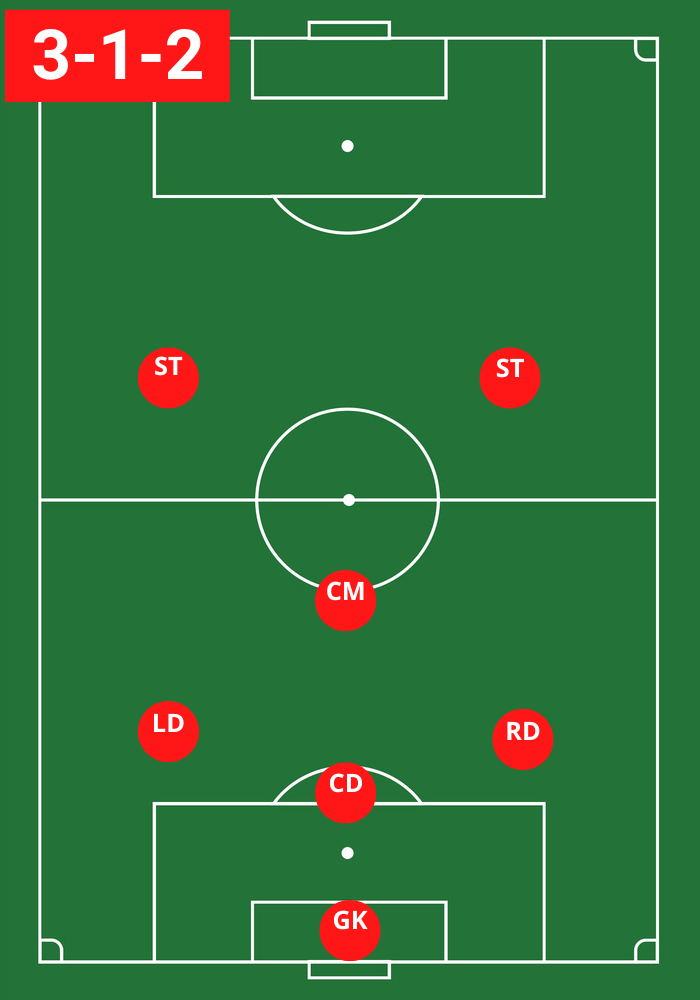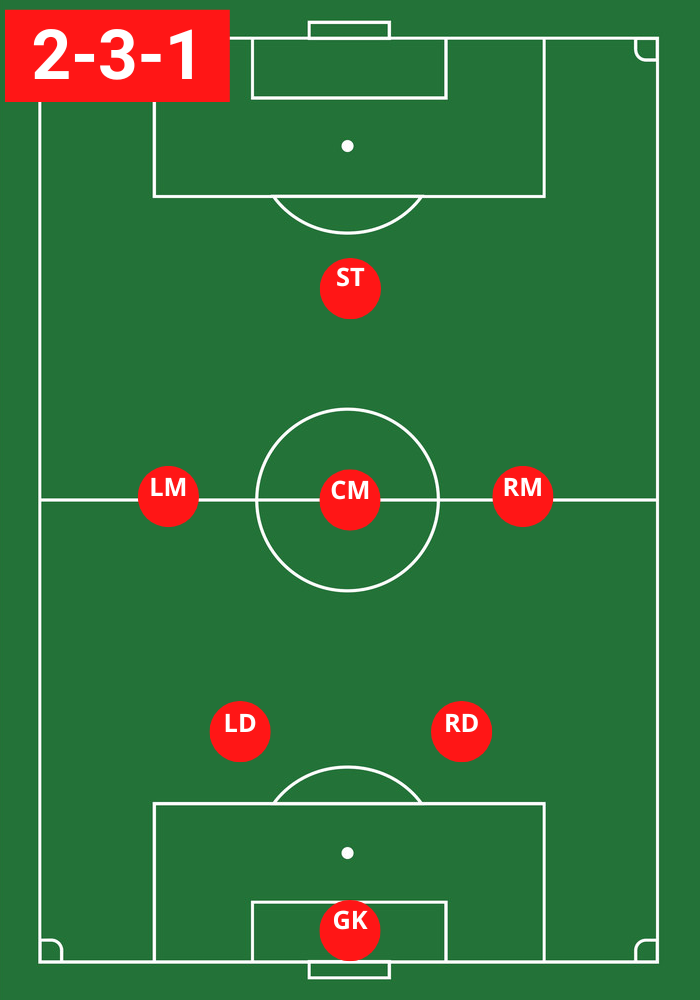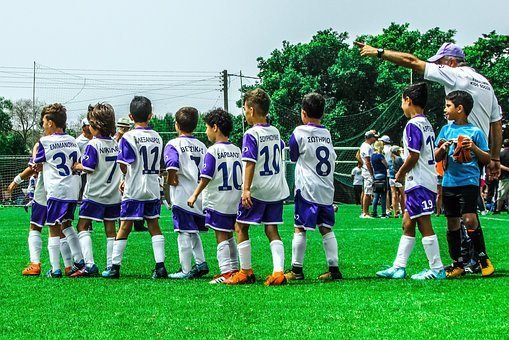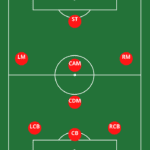7v7 Soccer Formations
- Last Updated -
What is the best 7v7 Soccer Formation?
Soccer is a game of strategy and skill, requiring players to work together to outmaneuver their opponents and score goals. The right formation can make all the difference in achieving victory, and the 7v7 format presents a unique set of challenges and opportunities.
With seven players on each side, finding the optimal balance between offense and defense is key. In this article, we will explore the most effective 7v7 soccer formations, their strengths and weaknesses, and tips for success.
The Classic 3-2-1 Formation
The 3-2-1 formation has gained popularity among teams seeking a more defensive style of play. It enables the team to maintain a solid backline of three defenders while still retaining control in midfield. The central defender is positioned higher than the fullbacks in this formation, highlighting their importance in stepping up to cover central areas in the absence of a dedicated central midfielder.
At times, the 3-2-1 formation can resemble the 2-1-2-1, with the main difference being the role of the central defender. In the 3-2-1, the central defender is typically a ball-playing center-half back, while in the 2-1-2-1, it’s usually a defensive midfielder.
The 3-2-1 formation has its advantages, such as providing strong defensive support and more midfield presence compared to the 3-1-2 formation. It also allows less skillful teams to overpower more fluid attacking formations.
However, the formation has its drawbacks, such as potential confusion for wide midfielders on when to move centrally or stay wide, and a lack of width if they remain too central. Additionally, the formation can upset team rhythm as the roles are less defined, and the central defender needs to step up into midfield when necessary.

2-1-2-1 Soccer Formation
The 2-1-2-1 formation is an innovative approach to the classic 2-3-1 formation, with a deeper central midfielder and higher wide players . This formation is very attack-oriented and supports a fast style of play, ensuring that the striker never becomes isolated. The shape of the formation is interesting and creative, making it difficult for opponents to know the best methods for counter-acting it.
However, there are a few drawbacks to the 2-1-2-1 formation. Attacking midfielders may be less inclined to help out in defense than if they were right/left midfielders in a 2-3-1 formation. If the defensive midfielder does not cover enough ground or gets caught too low, a massive gap can be created between the DM and AM’s. Additionally, a larger gap can be created between defenders and wide midfielders compared to the 2-3-1 formation.
Overall, with the right players and a central midfielder that can cover a lot of ground, the 2-1-2-1 formation could be the formation that catches any team by surprise . It also helps players clearly understand their role as either primarily an attacking player or a defensive player, which can help with the transition from the 5v5 game.

3-1-2 Formation
The 3-1-2 formation offers several advantages. With three strong defenders, the team can become indestructible in defense. The formation also helps forwards to learn how to work in a two-striker system and defend from the front. Additionally, it can be easier for strong, less skillful teams to overpower more skillful teams playing with more fluid attacking formations.
However, there are also some drawbacks to the 3-1-2 formation. The central midfielder is required to do a lot of running, and if they fail to do so, the opposing team may dominate the midfield. The formation can become overly defensive if the fullbacks don’t push up with the play, and it is not inherently rooted in a possession-based style of play. Nonetheless, these issues can be mitigated with fluidity in the fullbacks.
Overall, coaches and managers should consider the 3-1-2 formation for its defensive strength and tactical flexibility, particularly for younger players. While it has its drawbacks, it can be a valuable addition to any team’s formation repertoire.

3-1-1-1 Formation
The 3-1-1-1 formation is considered one of the best formations to teach 7v7 players the tactics of the game. It’s an ideal formation to switch to when trying to protect a lead or hold on to a draw. The formation also offers greater midfield support for teams that prefer to play with a back three compared to the 3-1-2 formation.
The 3-1-1-1 formation is most effective when there are specific players who can fit into the defined roles or when the team has a shortage of wide midfielders. However, the formation is narrow, which makes keeping possession in central areas crucial. It can also be used to make the wing-backs the most important players in the game.
The 3-1-1-1 formation has its advantages, such as providing a strong defensive line with three defenders and offering midfield support without sacrificing the attacking threat of the second striker. It also allows less skillful teams to overpower more fluid attacking formations.
However, there are drawbacks to this formation. It can become very narrow, and the fullbacks must provide width at the right moments. Teams may struggle against opponents that overload in wide areas. The formation can become overly defensive if fullbacks don’t push up with the play. Additionally, it’s not rooted in a possession-based style of play.

2-3-1 Soccer Formation
The 2-3-1 formation is a classic 7v7 formation that provides excellent balance and is easy for young players to understand. The two defenders are supported by three hard-working midfielders, which offers ample support at the back without overloading defensive areas.
At the same time, the midfield can push forward, and the wide players provide width during attacks. The lone striker is usually backed up by a central midfielder who can play as either a 6 or 10, depending on the situation, combining the best of both roles. This formation is effective in scoring goals and defending against various formations.
To succeed in this formation, teams require hard-working midfielders who can contribute both in attack and defense, particularly a central midfielder. They also need wingers who can stay wide and make short sprints up and down the line, a centre forward who can hold the line alone, and defenders who do not create massive gaps between themselves.

Tips for Success with 7v7 Soccer Formations
Regardless of which formation you choose, there are some key tips for success that can help your team dominate on the field. These include:
- Communication: Make sure your players are communicating effectively on the field, both in defense and attack.
- Movement: Encourage your players to move off the ball, creating space and opportunities for passes and shots.
- Flexibility: Be prepared to adjust your formation based on the strengths and weaknesses of your opponent and the game situation.
- Practice: Spend time on the training ground practicing different formations and scenarios, so your team is well-prepared for game day.
Q and A
Q: How do I choose the right formation for my team?
A: Consider the strengths and weaknesses of your players, the style of play you want to implement, and the opposing team’s formation and tactics. It’s also important to be flexible and willing to make adjustments during the game if needed.
Q: How can I encourage my team to move off the ball?
A: Incorporate drills in training that focus on movement off the ball, such as passing drills that require players to constantly change their position. Encourage players to look for space and make runs to create opportunities for themselves and their teammates.
Q: Is it better to focus on defense or offense in 7v7 soccer?
A: It’s important to find a balance between defense and offense in 7v7 soccer. While a strong defense can prevent goals, a strong offense is necessary to score goals and win games. Finding the right formation that fits your team’s strengths and weaknesses can help achieve this balance.
Conclusion:
Choosing the right 7v7 soccer formation is crucial for success on the field. Whether you opt for the classic 3-2-1, the 3-1-1-1, or the balanced 2-3-1, it’s important to consider the strengths and weaknesses of each formation and adapt to the game situation accordingly. Remember to focus on communication, movement, flexibility, and practice to give your team the best chance at winning.

Best Soccer Cleats For Defenders 2024
What are the Best Soccer Cleats for Defenders? In our opinion, the...
Read MoreBest Soccer Cleats For Wide Feet 2024
The world of soccer is vast, and players come in all shapes...
Read MoreHow Many Soccer Games In A Season
The number of soccer games in a season varies depending on the...
Read MoreThe Ultimate Guide to Soccer Field Size
How big is a soccer field? Read this post and get a...
Read MoreSoccer Position # 9 Center Forward Explained
Playing the # 9 soccer position, forward or Striker, is a crucial...
Read MoreSoccer Position # 4 Center Back Explained
Center Back in soccer is the # 4 Position, also known as...
Read MoreBest Adidas Soccer Cleats – Top 5 Picks
choosing the right type of soccer cleat is essential for optimal performance...
Read MoreThe Essential Soccer Skills Every Player Needs
From ball control to positioning, there are numerous technical aspects that every...
Read MoreMastering the Midfield Is The Key To Winning In Soccer
As soccer players try to gain control of the game, midfielders are...
Read More9v9 Soccer Positions Explained
9v9 soccer, also known as small-sided soccer, is a variation of the...
Read MoreTwo Soccer Skills That Are Essential
Shooting and Heading the soccer ball are both soccer skills you should...
Read MoreMastering Soccer Jargon: A Glossary for Fans and Players
Last Updated on August 27, 2024 by Andy Long Mastering Soccer Jargon:...
Read MoreBest Soccer Cleats For Goalkeepers 2024
Diving right into the heart of the matter, let's explore a question...
Read MoreThe Transformation of German Soccer in the 2000s
Kickoff: A Brief Overview of German Soccer in the 2000s The Dawn...
Read MoreBest Soccer Cleats for Women In 2024: Top 5 Picks
The Best Soccer Cleats for Women in 2023: Top 5 Picks The...
Read MoreThe Historical Dominance of Brazilian Soccer in the World Cup
Introduction: The Beautiful Game's Grandest Stage The World Cup, a grand tournament...
Read More5 Best Soccer Cleats For Strikers in 2024
What are the Best Soccer Cleats for Strikers? The beautiful game of...
Read MoreAn Introduction and History of UEFA Champions League
In terms of prestige, nothing surpasses lifting ‘the cup with big ears’,...
Read MoreThe Golden Era of Italian Soccer in the 1990s
A Glimpse into Italy of the 90s: Culture, Politics, and Soccer As...
Read MoreWhat is a goal kick in soccer? Soccer Law #16
Soccer is governed by a set of rules known as the Laws...
Read MoreConcussion Substitutions in Soccer: evolving concussion protocols
The Growing Concern for Player Safety in Soccer Soccer, a beloved sport...
Read MoreThe Impact of VAR on Modern Soccer: Video Assistant Referee
Traditional Refereeing Methods: Balancing Act on the Pitch In the realm of...
Read MoreThe Changing Role of Inverted Wingers
Definition of 'Inverted Wingers' in soccer An inverted winger, also known as...
Read MoreBest Soccer Cleat Insoles – VKTRY Insoles
Try VKTRY Insoles to Improve Your Athletic Performance Now, let's delve into...
Read MoreThe Changing Role of Wingers in Soccer
The Changing Role of Wingers in Soccer. Soccer has captivated millions around...
Read MoreThe Transformation of Midfielders Roles in Soccer
The Transformation of Midfield Roles in Soccer The Evolution of Soccer Tactics...
Read MoreVersatile Soccer Players: Chameleons of the Pitch
Ah, the beautiful game of soccer! A sport that has captivated millions...
Read MoreThe Changing Role of Strikers in Soccer
The Changing Role of Strikers in Modern Soccer Soccer, known as the...
Read More5 Best Soccer Cleats For Speed In 2024
Our Top 5 Picks for the Best Soccer Cleats for Speed in...
Read MoreBest Soccer Ball For Games in 2024: Top 5 Picks
The Importance of Having a Good Soccer Ball for Training Soccer requires...
Read Moresoccer start and restart of play
Brief Overview: Soccer as a Popular Sport Worldwide Soccer's popularity stems from...
Read MoreSoccer Referee Roles and Responsibilities
The Crucial Role of a Soccer Referee In the vast realm of...
Read MoreDiscover the 5 different types of soccer cleats
Introduction - A brief overview of the importance of choosing the right...
Read MoreSoccer Throw In Rules – Soccer Law #15
Law Number 15 - Throw Ins A throw-in in soccer is granted...
Read MoreSoccer 6-Yard Box: The Penalty Area
What is the 6-Yard Box in Soccer? The 6-Yard Box is an...
Read MoreBest Soccer Ball for Training: Top 5 Picks
The Importance of Having a Good Soccer Ball for Training Soccer requires...
Read More



































